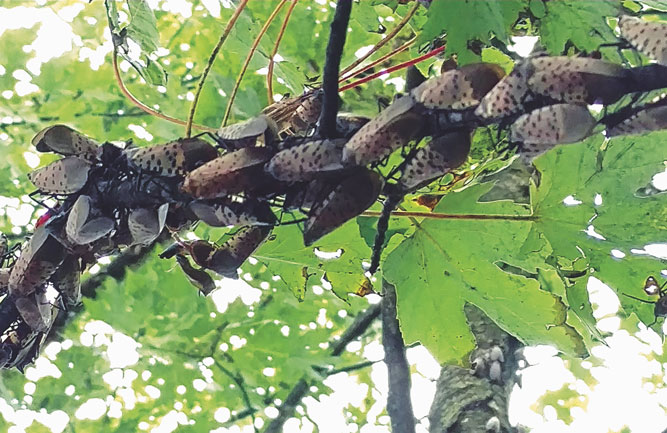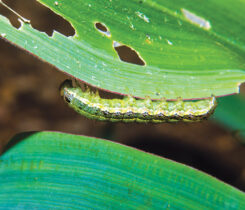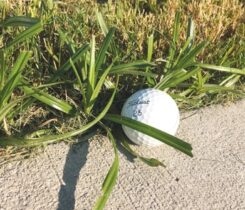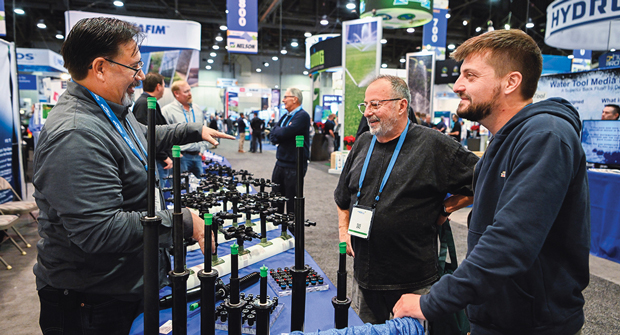Turf Pest of the Month: Debunking common myths about spotted lanternfly
It’s September and your course has one final tournament for the season. A week before the event, 1-inch-long pests — spotted lanternflies (SLF) with gray wings and black spots — descend upon the course in swarms. Brian Walsh, Penn State Extension horticulture educator for Berks County helps debunk some common myths about these pests before they infest your course.
Myth 1: They’re hard to kill
Walsh says plenty of chemicals kill spotted lanternfly adults. “Even the softest insecticides can kill them,” he says. “Even soaps and low-toxicity insecticides are very effective.”

When spotted lanternflies first infest a new area, adults will swarm properties. (Photo: Brian Walsh)
Walsh warns, though, that superintendents who apply insecticides to reduce large adult populations may need to remove dead adults.
“You should have a plan for vacuuming them up,” he says. “When they pile up, it can start to smell like roadkill on an August day.”
Myth 2: Spray everything
Walsh says superintendents should avoid blanket insecticide applications to control every spotted lanternfly population, especially in wooded areas. A Penn State University Extension guide breaks down the pest’s favored hosts, which can help superintendents time and target applications effectively. He says the pest’s preferences in hosts change depending on the season, so it’s important to understand SLF’s behavior before applying.
“If you target those preferred hosts with your treatment, you get more bang for your buck with the treatment,” he says.
Myth 3: They’re easy to control
“You can spray them, kill ‘em, and they can keep coming in,” he says. “Populations can just suddenly jump by thousands on a property overnight and it’s a reality that we have to deal with. We have to reset our expectations of what we can actually control.”
Walsh suspects lanternfly populations can move seven to 10 miles per year. Spotted lanternflies — originally detected in Berks County, Pa. — are now found as far west as Indiana, as far north as Vermont and as far south as North Carolina, thanks to the pest’s penchant for hitchhiking. Mid-fall, adults make dispersion flights, where the pest will swarm a property.
“That’s when you see those sudden onslaughts of numbers that blow people away,” he says.
Myth 4: It’ll always be bad
Walsh says there are ebbs and flows to spotted lanternfly infestations. When the pest first arrives in an area, superintendents worry populations will build over several seasons into swarms of biblical proportions. That won’t always be the case, he says.
“It seems like the first wave in a new area builds and builds. It seems like it’s not going to end season after season, but then it does,” he says. “We’ve seen them dissipate down to almost nothing. Then, unfortunately, on a couple of those properties, we’ve also seen them rebound.”
Myth 5: They harm people
While spotted lanternflies won’t harm golfers and members, the pest is a nuisance. It damages trees as it feeds. Spotted lanternflies secrete a honeydew following feeding, which can attract yellowjackets, wasps and hornets. The honeydew can also cause sooty mold on trees.
“From a golf course management standpoint, the nuisance aspect can be phenomenal,” he says. “The honeydew dripping down makes it unpleasant for people who are paying to be there.”
It’s important to understand the pest and educate your members about economical treatment options.
“Depending on if the trees are around the clubhouse, management might need to be stepped up a little bit to prevent an economic loss,” he says. “Education will make a huge difference in how dollars are potentially spent.”












